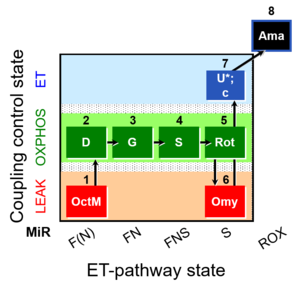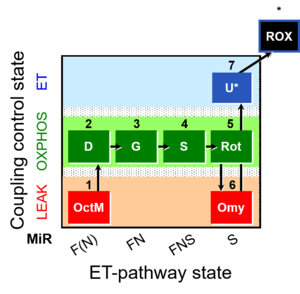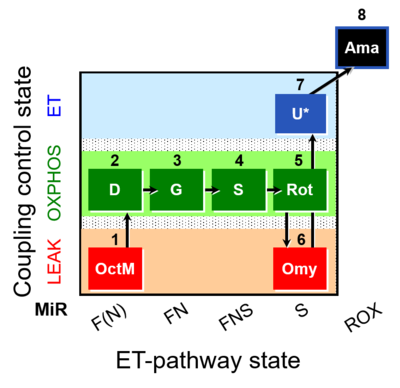SUIT-016: Difference between revisions
From Bioblast
No edit summary |
No edit summary |
||
| Line 2: | Line 2: | ||
|abbr=FNS(Oct,GM) | |abbr=FNS(Oct,GM) | ||
|description=[[File:1OctM;2D;3G;4S;5Rot;6Omy;7U-.png|300px]] | |description=[[File:1OctM;2D;3G;4S;5Rot;6Omy;7U-.png|300px]] | ||
|info='''A''' [[ | |info='''A''' [[File:PDF.jpg|100px|link=http://wiki.oroboros.at/images/6/64/SUIT-016.pdf|Bioblast pdf]] »[http://wiki.oroboros.at/index.php/File:SUIT-016.pdf Versions] | ||
}} | }} | ||
::: '''[[Categories of SUIT protocols |SUIT-category]]:''' FNS(Oct,GM) | ::: '''[[Categories of SUIT protocols |SUIT-category]]:''' FNS(Oct,GM) | ||
::: '''[[SUIT protocol pattern]]:''' diametral 1OctM;2D;3G;4S;5Rot;6Omy;7U | ::: '''[[SUIT protocol pattern]]:''' diametral 1OctM;2D;3G;4S;5Rot;6Omy;7U | ||
__TOC__ | __TOC__ | ||
== DLP applications == | |||
== References == | == References == | ||
{{#ask:[[Category:Publications]] [[Additional label::1OctM;2D;3G;4S;5Rot;6Omy;7U-]] | {{#ask:[[Category:Publications]] [[Additional label::SUIT-016]] [[Additional label::1OctM;2D;3G;4S;5Rot;6Omy;7U-]] | ||
|?Was published in year=Year | |?Was published in year=Year | ||
|?Has title=Reference | |?Has title=Reference | ||
| Line 21: | Line 23: | ||
}} | }} | ||
{{Template:SUIT-016}} | |||
== | == Strengths and limitations == | ||
== Compare SUIT protocols == | |||
[[File:1OctM;2D;3G;4S;5Rot;6Omy;7U;7c;8Ama.png|300px]] 1OctM;2D;3G;4S;5Rot;6Omy;7U;7c;8Ama | |||
{{MitoPedia concepts | {{MitoPedia concepts | ||
Revision as of 11:45, 15 January 2019
Description
Abbreviation: FNS(Oct,GM)
Reference: A ![]() »Versions
»Versions
- SUIT-category: FNS(Oct,GM)
- SUIT protocol pattern: diametral 1OctM;2D;3G;4S;5Rot;6Omy;7U
DLP applications
References
| Year | Reference | Organism | Tissue;cell | |
|---|---|---|---|---|
| Gnaiger 2015 Scand J Med Sci Sports | 2015 | Gnaiger E, Boushel R, Søndergaard H, Munch-Andersen T, Damsgaard R, Hagen C, Díez-Sánchez C, Ara I, Wright-Paradis C, Schrauwen P, Hesselink M, Calbet JAL, Christiansen M, Helge JW, Saltin B (2015) Mitochondrial coupling and capacity of oxidative phosphorylation in skeletal muscle of Inuit and caucasians in the arctic winter. https://doi.org/10.1111/sms.12612 | Human | Skeletal muscle |
Steps and respiratory states
| Step | State | Pathway | Q-junction | Comment - Events (E) and Marks (M) |
|---|---|---|---|---|
| 1OctM | OctML(n) | F(N) | CETF | 1OctM
|
| 2D | OctMP | F(N) | CETF | 1OctM;2D
|
| 3G | OctGMP | FN | CETF&I | 1OctM;2D;3G
|
| 4S | OctGMSP | FNS | CETF&CI&II | 1OctM;2D;3G;4S
|
| 5Rot | SP | S | CII | 1OctM;2D;3G;4S;5Rot
|
| 6Omy | SL(Omy) | S | CII | 1OctM;2D;3G;4S;5Rot;6Omy
|
| 7U | SE | S | CII | 1OctM;2D;3G;4S;5Rot;6Omy;7U
|
| 8Ama | ROX | 1OctM;2D;3G;4S;5Rot;6Omy;7U;8Ama
|
| Step | Respiratory state | Pathway control | ET-Complex | Comment |
|---|---|---|---|---|
| ## AsTm | AsTmE | CIV | CIV | |
| ## Azd | CHB |
- Bioblast links: SUIT protocols - >>>>>>> - Click on [Expand] or [Collapse] - >>>>>>>
- Coupling control
- Pathway control
- Main fuel substrates
- » Glutamate, G
- » Glycerophosphate, Gp
- » Malate, M
- » Octanoylcarnitine, Oct
- » Pyruvate, P
- » Succinate, S
- Main fuel substrates
- Glossary
Strengths and limitations
Compare SUIT protocols
 1OctM;2D;3G;4S;5Rot;6Omy;7U;7c;8Ama
1OctM;2D;3G;4S;5Rot;6Omy;7U;7c;8Ama
MitoPedia concepts:
SUIT A
MitoPedia methods:
Respirometry



